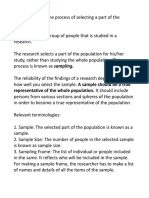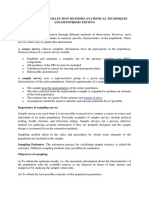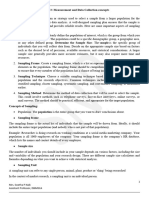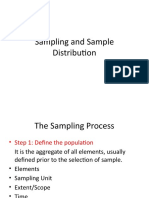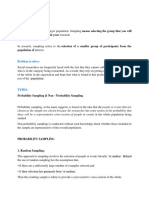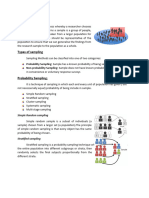Sampling BRM For
Uploaded by
22MBA320-KOLANCHIYAMMAL R MBASampling BRM For
Uploaded by
22MBA320-KOLANCHIYAMMAL R MBAIn business research, sampling refers to the process of selecting a subset of individuals or entities
from a larger population that is representative of the population as a whole. Sampling is an
essential aspect of research methodology as it allows researchers to gather data that is both
accurate and reliable, while also minimizing costs and time involved in data collection.
There are several sampling methods used in business research, including:
Probability Sampling: Probability sampling is a method that involves selecting individuals or
entities from a population using a random process. This ensures that every member of the
population has an equal chance of being selected, and that the sample is representative of the
population. Some common probability sampling methods include simple random sampling,
stratified random sampling, and cluster sampling.
Non-Probability Sampling: Non-probability sampling is a method that involves selecting
individuals or entities from a population using a non-random process. This means that some
members of the population may have a higher chance of being selected than others, which can
affect the representativeness of the sample. Some common non-probability sampling methods
include convenience sampling, purposive sampling, and snowball sampling.
Quota Sampling: Quota sampling is a method that involves selecting individuals or entities from
a population based on specific characteristics or quotas. For example, if a researcher wanted to
sample a population based on age and gender, they would set quotas for each group and select
individuals to meet those quotas.
Cluster Sampling: Cluster sampling is a method that involves selecting groups or clusters of
individuals or entities from a population, rather than selecting individual members. This method
is often used when the population is geographically dispersed, and it can be more cost-effective
than other sampling methods.
In conclusion, sampling is an important aspect of business research, and researchers must
carefully consider the sampling method that best fits their research objectives, population size,
and available resources. By selecting a representative sample, researchers can gather data that
accurately reflects the population, which can lead to more accurate and reliable research
findings.
Types of probability sampling
Simple Random Sampling: Simple random sampling is a basic probability sampling method
where each member of the population has an equal chance of being selected for the sample. This
method involves selecting individuals randomly from the population without any bias, making it
an unbiased method of sampling.
Systematic Sampling: Systematic sampling is a probability sampling method where the
researcher selects a random starting point from the population and then selects every nth
individual from the population to be included in the sample. This method is useful when the
population is too large to select individuals randomly.
Stratified Sampling: Stratified sampling is a probability sampling method where the population is
divided into homogeneous subgroups or strata based on a characteristic of interest. Then, a
simple random sample is drawn from each stratum. This method ensures that the sample is
representative of the entire population.
Cluster Sampling: Cluster sampling is a probability sampling method where the population is
divided into clusters, and a random sample of clusters is selected. The researcher then collects
data from all members of the selected clusters. This method is useful when the population is
dispersed geographically.
Types of non-probability sampling
Convenience Sampling: Convenience sampling is a non-probability sampling method where the
researcher selects individuals who are most easily accessible or convenient to the researcher.
This method is often used when time and resources are limited.
Purposive Sampling: Purposive sampling is a non-probability sampling method where the
researcher selects individuals based on specific characteristics that are important to the research.
This method is useful when the researcher wants to target a specific population or subgroup.
Quota Sampling: Quota sampling is a non-probability sampling method where the researcher
selects individuals based on pre-determined quotas for certain characteristics, such as age,
gender, or race. This method is useful when the researcher wants to ensure that the sample is
representative of certain characteristics of the population.
Snowball Sampling: Snowball sampling is a non-probability sampling method where the
researcher initially selects a small group of individuals who meet the criteria for the study, and
then asks them to refer other individuals who meet the criteria. This method is useful when the
population is hard to access or identify.
The following are the general steps involved in sampling in research:
Define the Population: The first step in sampling is to define the population of interest. The
population should be clearly defined based on the research question or problem.
Determine the Sampling Frame: The sampling frame is a list of all individuals or units in the
population from which the sample will be drawn. The sampling frame should be accurate, up-to-
date, and accessible.
Choose the Sampling Method: The sampling method should be selected based on the research
question, available resources, and level of accuracy required. Probability sampling methods, such
as simple random sampling, systematic sampling, stratified sampling, and cluster sampling, are
commonly used in research.
Determine the Sample Size: The sample size should be determined based on the research
question, population size, desired level of accuracy, and available resources. The larger the
sample size, the more representative the sample will be of the population.
Select the Sample: Once the sampling method and sample size are determined, the sample can be
selected. The sample should be selected using the chosen sampling method and should be
representative of the population.
Collect Data from the Sample: Data can be collected from the sample using various data
collection methods, such as surveys, interviews, observations, and secondary data sources.
Analyze the Data: The data collected from the sample should be analyzed using appropriate
statistical methods. The results can be used to draw conclusions and make inferences about the
population.
Here are some key questions that should be asked when designing a sampling strategy:
What is the research question or problem?
The research question or problem should be clearly defined to determine the population of
interest.
Who is the population of interest?
The population should be defined based on the research question or problem.
What is the sampling frame?
The sampling frame is a list of all individuals or units in the population from which the sample
will be drawn. It should be accurate, up-to-date, and accessible.
What is the sampling method?
The sampling method should be chosen based on the research question, available resources, and
level of accuracy required.
What is the sample size?
The sample size should be determined based on the research question, population size, desired
level of accuracy, and available resources.
What is the sampling interval or selection criteria?
The sampling interval or selection criteria should be determined based on the chosen sampling
method.
What is the level of precision or confidence desired?
The level of precision or confidence desired should be determined based on the research question
and available resources.
What is the margin of error?
The margin of error should be determined based on the sample size and level of precision
desired.
What is the response rate?
The response rate is the percentage of individuals or units that respond to the survey or
questionnaire.
What are the ethical considerations?
Ethical considerations should be taken into account when selecting the sample and collecting
data from the sample.
Advantages of Sampling:
Cost-effective: Sampling is generally less expensive and time-consuming than collecting data
from the entire population. This is because it requires fewer resources, such as manpower,
materials, and finances.
Time-saving: Sampling enables researchers to collect data within a shorter period of time, as it
only involves a subset of the population.
Convenience: Sampling is more convenient than collecting data from the entire population, as it
requires less effort and resources.
Accuracy: Sampling can be as accurate as collecting data from the entire population if the
sample is representative of the population and the sample size is sufficient.
Disadvantages of Sampling:
Sampling error: Sampling error occurs when the sample is not representative of the population or
the sample size is too small. This can result in biased or inaccurate results.
Bias: Sampling bias occurs when the sample is not randomly selected or is not representative of
the population. This can result in inaccurate or skewed results.
Difficulty in selecting an appropriate sample: It can be challenging to select an appropriate
sample that is representative of the population, especially when the population is large and
diverse.
Generalizability: The results obtained from a sample may not be generalizable to the entire
population. This is because the sample is only a subset of the population, and there may be
differences between the sample and the population.
You might also like
- The Hound of The Baskervilles Creative ProjectNo ratings yetThe Hound of The Baskervilles Creative Project7 pages
- Types of Sampling Sampling Methods With Examples QuestionProNo ratings yetTypes of Sampling Sampling Methods With Examples QuestionPro1 page
- What Is Sampling?: Sampling Definition: Sampling Is A Technique of Selecting IndividualNo ratings yetWhat Is Sampling?: Sampling Definition: Sampling Is A Technique of Selecting Individual6 pages
- Types of Sampling - Sampling Methods With Examples - QuestionProNo ratings yetTypes of Sampling - Sampling Methods With Examples - QuestionPro1 page
- Research - Sampling Methods and TechniquesNo ratings yetResearch - Sampling Methods and Techniques7 pages
- 2.0 Methods of Sampling and Their ComparisonNo ratings yet2.0 Methods of Sampling and Their Comparison26 pages
- Pangilinan - Rodel - Med001 - Final RequiremnetsNo ratings yetPangilinan - Rodel - Med001 - Final Requiremnets3 pages
- Donnie Marie Plaza - Sampling Techniques (March 06 2022)No ratings yetDonnie Marie Plaza - Sampling Techniques (March 06 2022)34 pages
- Sampling Techniques: of The Population Has A Chance of Being IncludedNo ratings yetSampling Techniques: of The Population Has A Chance of Being Included10 pages
- Sample Definition: A Sample Is A Group of Units Selected From A Larger Group (TheNo ratings yetSample Definition: A Sample Is A Group of Units Selected From A Larger Group (The7 pages
- Survey Sampling in Methods of Social ResearchNo ratings yetSurvey Sampling in Methods of Social Research2 pages
- A Single Stage Flyback Power Supply Unit For LED Lighting ApplicationsNo ratings yetA Single Stage Flyback Power Supply Unit For LED Lighting Applications5 pages
- EBOOK - Diálogos e Perspectivas Da Análise Crítica Do Discurso (Cirne - Barros e Efken - Editora Pontes)No ratings yetEBOOK - Diálogos e Perspectivas Da Análise Crítica Do Discurso (Cirne - Barros e Efken - Editora Pontes)284 pages
- Full Download Moving On To Key Stage 1 Improving Transition From The Early Years Foundation Stage 1st Edition Julie Fisher PDF100% (3)Full Download Moving On To Key Stage 1 Improving Transition From The Early Years Foundation Stage 1st Edition Julie Fisher PDF84 pages
- Warren D. KissinJulio Herrera, (1990), International Mergers and Acquisitions - Due Diligence - ECON PDFNo ratings yetWarren D. KissinJulio Herrera, (1990), International Mergers and Acquisitions - Due Diligence - ECON PDF6 pages
- Gagne Et Al EJWOP 2015 Scale ValidationNo ratings yetGagne Et Al EJWOP 2015 Scale Validation20 pages
























